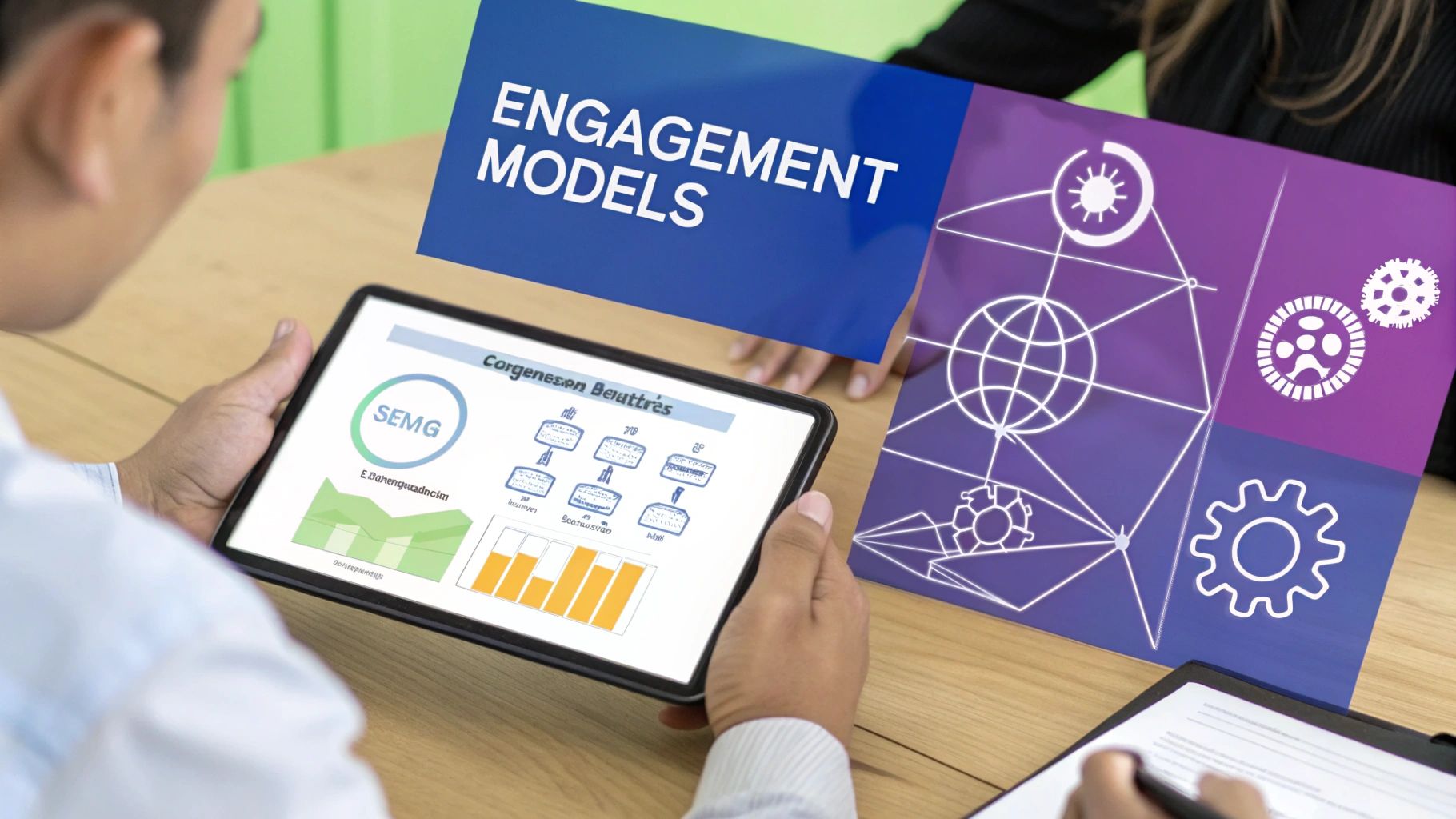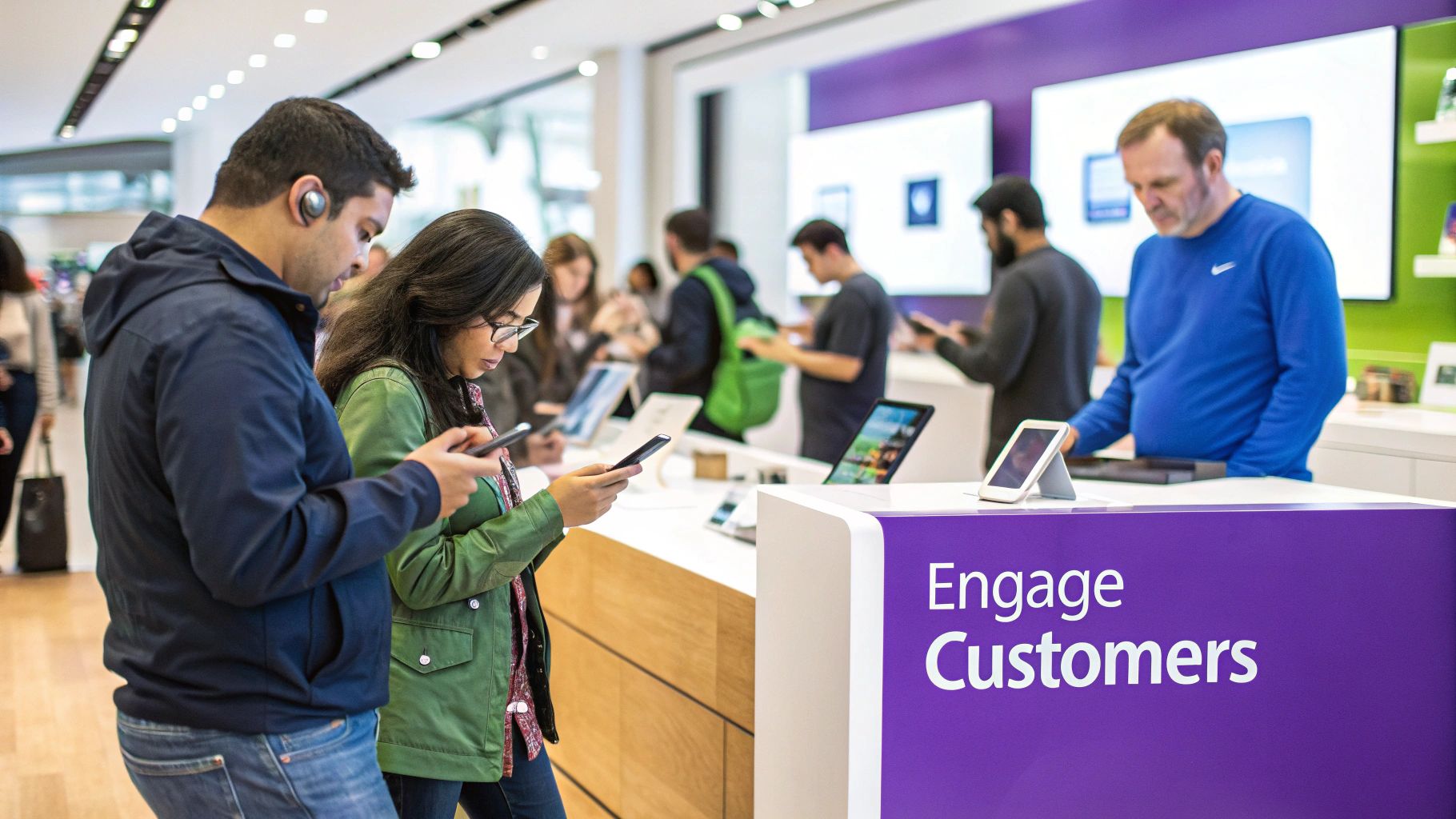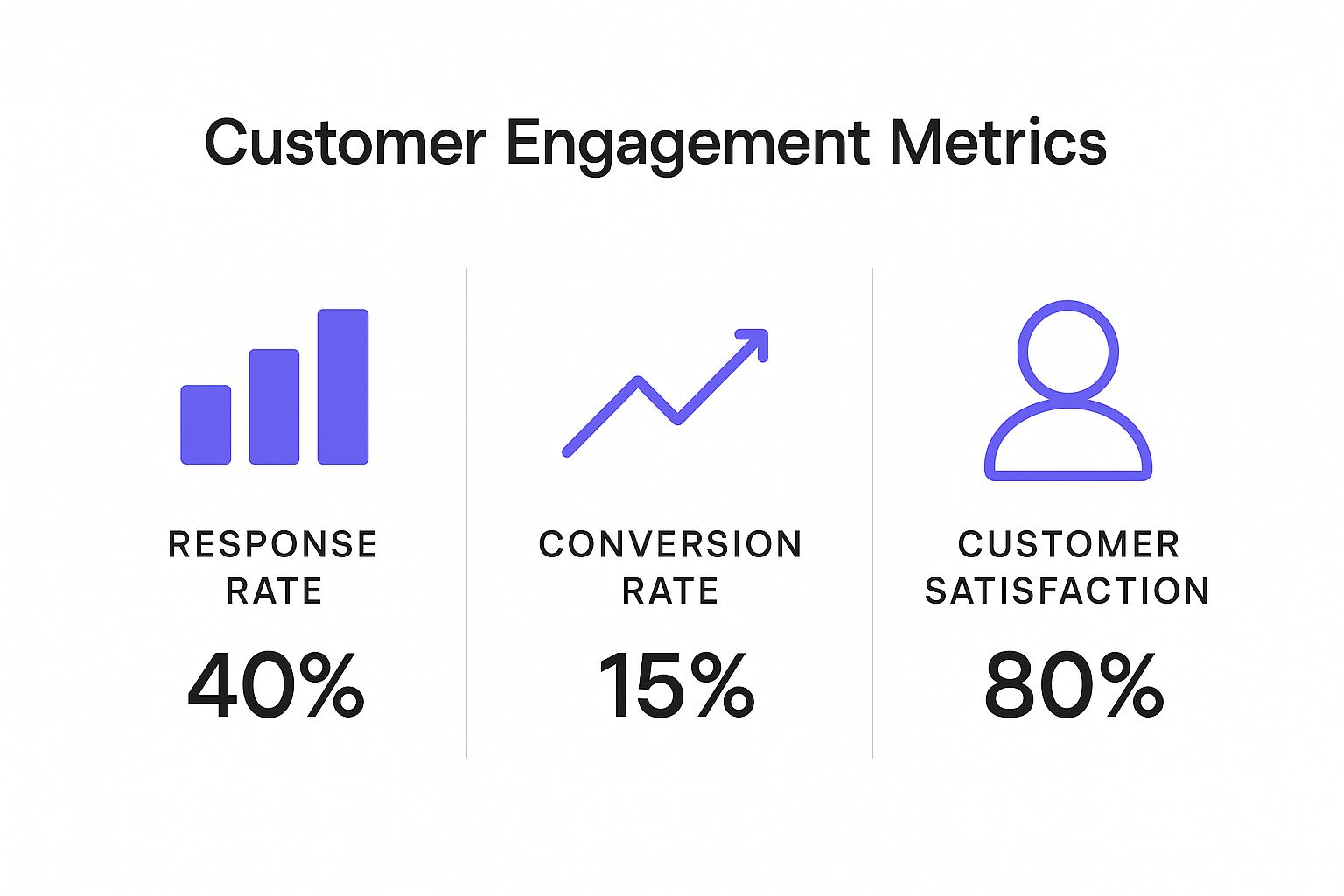
Think of customer engagement models less as a rigid set of rules and more as a strategic playbook for how you interact with your customers. They’re the blueprints that guide your teams in building strong, lasting relationships by making sure you give the right amount of attention to the right people.

At its heart, the idea is pretty simple. Instead of a one-size-fits-all approach, these models help you strategically invest your most valuable resources—your team's time and your company's money—where they’ll make the biggest difference. After all, not every customer needs or even wants the same level of hand-holding.
For instance, a major enterprise client wrestling with a complex piece of software will almost certainly need a dedicated, personal touch to get real value. On the other hand, a small business using a straightforward, self-service tool is often perfectly content with great documentation and a few automated check-ins.
Trying to give every single user a dedicated manager would be financially disastrous. But offering zero human support to your biggest accounts? That’s a surefire way to watch them walk out the door. This is exactly where customer engagement models bring much-needed clarity, ensuring your interactions are helpful for the customer and sustainable for your business.
In today's competitive world, treating every customer the same just doesn't work. A generic strategy ignores the fact that different customers have vastly different needs, goals, and, frankly, different value to your business. This approach usually creates two big headaches:
By implementing a structured engagement model, companies can align their service levels with customer value. This alignment is crucial for maximizing customer lifetime value (CLV) and driving sustainable growth.
The ultimate goal is to craft a positive and productive experience for every customer, from the moment they first hear about you to the day they become a vocal advocate. A smart model helps you get ahead of their needs, solve problems before they escalate, and actively guide them toward success with your product.
To get started, let's explore the three core models that are the bedrock of most customer engagement strategies today. These models exist on a spectrum, moving from deeply personal interactions to fully automated ones.
The table below breaks down the primary engagement models, highlighting their level of interaction, main objective, and the type of customer they're best suited for. This gives a quick snapshot of how to match your efforts to your customer base.
As we dig deeper into each of these, you'll see how they can be blended and adapted to create a sophisticated strategy that feels personal to every customer while remaining efficient for your team.

The classic engagement models—High-Touch, Low-Touch, and Tech-Touch—have long been the bedrock of Customer Success. They give us a solid framework. But a new force is fundamentally changing what's possible within each of them: artificial intelligence. AI isn't just another tool anymore; it's quickly becoming the engine that powers smarter, faster, and more predictive engagement.
This shift is less of an update and more of a complete upgrade, moving us from reactive, manual work to a proactive and deeply personal approach.
Think about it this way: the old models are like a paper map. The map is reliable and shows you the roads, but that's all it does. AI is like a modern GPS. It doesn't just show you the map; it analyzes traffic, predicts delays, and finds a better route in real-time. That's what AI is starting to do for our customer relationships.
This technology doesn't just help one model; it elevates all of them. In a High-Touch world, AI sifts through mountains of data to arm CSMs with critical insights for strategic calls. For Tech-Touch, it’s the brains behind the intelligent chatbots and automated help centers that offer instant, 24/7 support.
Before AI became mainstream, our engagement strategies were mostly driven by playbooks and manual triggers. A CSM would get an alert to call a customer because their product usage dropped or they logged a support ticket. It worked, but it was always a step behind. It depended on something bad happening first.
AI completely flips that script. It introduces a predictive layer that changes the game. Instead of waiting for a fire alarm, AI-powered systems can detect the subtle whispers of smoke—the tiny signals that predict a customer is about to churn or, on the flip side, is perfectly primed for an upsell.
How does it do this? By connecting the dots between different data points:
By pulling all this information together, AI gives us a forward-looking picture of customer health. It allows teams to stop being firefighters and start being fire marshals, preventing problems before they ever begin.
The real magic of AI here is its ability to process more data, and do it faster, than any human team ever could. This creates insights that aren't just descriptive (telling you what happened) but predictive (telling you what’s likely to happen next). That's how we get to truly proactive engagement.
Integrating AI isn't about throwing out the models we know and trust. It's about making them better—more effective, more scalable, and a whole lot smarter.
Enhancing High-Touch ModelsFor your most valuable accounts, AI becomes a CSM's strategic sidekick. It can automatically summarize meeting notes, suggest talking points based on a customer's recent activity, and flag accounts that are showing early warning signs of risk. This clears the administrative clutter off the CSM's plate so they can focus on what they do best: building relationships and providing high-level guidance.
Supercharging Low-Touch and Tech-Touch ModelsThis is where AI-driven automation really shines. It makes personalization at scale a reality. For instance, an AI can trigger a perfectly timed in-app guide the moment a user seems to be struggling with a new feature. Or, it can identify your power users and automatically send them a targeted email about an advanced feature they're ready for.
The numbers back this up. By 2025, artificial intelligence is expected to power the vast majority of customer interactions. Some estimates suggest AI will assist in 95% of all engagements. That means 19 out of every 20 interactions will have AI involved, whether through chatbots or advanced voice assistants.
If you want to go deeper on how AI is changing the game, check out these 7 Game-Changing Applications of AI in Customer Support.
When we talk about customer engagement, we're really talking about three core approaches that form the foundation of any solid Customer Success strategy. It’s important to see these not as rigid, separate boxes, but as points along a flexible spectrum. Each model uses a different mix of resources and tactics, but they all share the same North Star: guiding your customers to see real value.
To really get a feel for these, let's use a few simple analogies. Think of the High-Touch model as a dedicated 'personal concierge' service. The Low-Touch model is more like a 'group workshop,' and the Tech-Touch model is a 'self-service digital library.' Each one is built for a different kind of customer with different needs.

The High-Touch model is all about creating deep, personal, one-on-one relationships. This white-glove treatment is reserved for your most strategic, high-value accounts—the ones whose investment size and product complexity demand a dedicated human partner.
In this setup, a Customer Success Manager (CSM) manages a very small portfolio of clients. Their job isn't just to manage an account; it's to become a trusted advisor who deeply understands the customer's business goals, internal dynamics, and biggest pain points.
Every interaction here is proactive and strategic. Common activities include:
This approach is expensive and requires significant resources, which is why it’s exclusively for accounts with the highest Customer Lifetime Value (CLV). The goal here moves beyond just preventing churn; it’s about driving major expansion and turning happy customers into your biggest advocates. As you build out these high-value relationships, mastering skills like meeting facilitation techniques becomes critical for ensuring every interaction is impactful.
Moving along the spectrum, we find the Low-Touch model, which focuses on delivering value to many customers at once. If High-Touch is a private coaching session, Low-Touch is a university lecture or a hands-on workshop. It smartly blends targeted human interaction with scalable, one-to-many communications.
This strategy is a perfect fit for your mid-market customers or those growing accounts that don't quite justify a dedicated CSM but still benefit from proactive guidance. It’s all about finding the sweet spot between efficiency and effectiveness.
Key activities in a Low-Touch world often involve:
With this model, a single CSM can effectively manage a much larger book of business. They lean on data to spot at-risk accounts or identify upsell opportunities, stepping in with a personal touch only when it’s truly needed. It's the art of being proactive at scale.
At the other end of the spectrum lies the Tech-Touch model, an approach that is almost entirely automated and technology-driven. This is your 'self-service digital library,' where customers are empowered to find their own answers and achieve success on their own schedule, 24/7. This model is non-negotiable for businesses with a huge volume of low-ARR (Annual Recurring Revenue) customers, like most B2C apps or freemium SaaS products.
The heart of the Tech-Touch model is about building guidance directly into the product and its surrounding digital ecosystem. The goal is to make the user experience so intuitive that direct human help becomes the exception, not the rule.
Here, the entire customer journey is orchestrated through technology:
A well-executed Tech-Touch model allows a company to support thousands—or even millions—of users with a surprisingly small team. Its success lives and dies by the quality of the digital content and the intelligence of the automation behind it.
To bring it all together, it's helpful to see these three models laid out side-by-side. Each has a distinct purpose and is measured in different ways.
Understanding these differences is the first step toward building a segmented engagement strategy that delivers the right level of support to the right customer at the right time. Ultimately, the best Customer Success organizations often blend elements from all three models to create a cohesive and efficient customer experience.
No matter which customer engagement model you choose, there's a powerful ingredient that makes every single one of them work better: hyper-personalization.
We're not just talking about using a first name in an email. This is about using deep customer data to make every interaction feel like it was created just for them.
Think about the difference between a big-box department store and a personal stylist. The department store has tons of options, but you're on your own to figure out what fits. A great personal stylist, on the other hand, knows your tastes, your history, and your goals. They don't just find you clothes; they anticipate what you’ll love and build an entire look for you. That's what real personalization feels like.
It's this shift that turns basic transactions into real, trust-based relationships. It’s the magic that builds loyalty, whether you’re working with a high-touch or tech-touch model.
So, what's driving this change? It's the powerful combination of AI and machine learning. These systems can sift through enormous amounts of customer information—product usage, purchase history, browsing behavior, support tickets—and spot patterns that a human team could never catch.
This allows you to stop being reactive and start being predictive. Instead of waiting for a customer to hit a wall and ask for help, you can see the problem coming and offer a solution before they even know they need it.
We’ve all seen this in action with B2C giants like Netflix and Spotify. They don’t just recommend a movie or song based on your past ratings; their algorithms are constantly predicting what you’ll want to watch or listen to next. Now, that same predictive power is changing the game in B2B.
Imagine a Customer Success platform that can:
When every touchpoint is this relevant and timely, it reinforces the value you provide and strengthens the entire customer relationship.
True hyper-personalization is about treating each customer as a "segment of one." It’s seeing their unique situation and delivering an experience that proves you’re not just a vendor—you're a partner invested in their success.
Hyper-personalization isn't a standalone strategy. Think of it as a powerful layer you add on top of your existing engagement models to make them better. It makes high-touch interactions feel more strategic and tech-touch communications feel surprisingly human.
In High-Touch Models:Instead of just reviewing past performance, a CSM can walk into a Quarterly Business Review armed with AI-powered insights. They can show the client exactly how their teams are adopting features, where they're excelling, and what hidden growth opportunities exist. The conversation immediately becomes more strategic and valuable.
In Low-Touch and Tech-Touch Models:This is where personalization truly shines at scale. Automated emails can be triggered by precise user actions, delivering the right tip at the exact moment it's needed. In-app messages can act like a personal guide, walking a user through a complicated workflow and making a self-service model feel incredibly supportive.
Looking ahead, this blend of AI and personalization is completely redefining the field. By 2025, customer engagement is expected to be dominated by AI-driven personalization and experiential rewards built around individual user behavior. Brands are already using AI to analyze psychographic data and browsing history to anticipate what customers need, creating bespoke experiences that forge real emotional connections. You can learn more about how these customer engagement trends are shaping the future.
This isn't just a trend; it's a fundamental shift away from generic, transactional communication toward authentic, data-informed partnerships. By embracing it, you can create experiences that resonate deeply with your customers, driving both revenue and unshakable loyalty.

This is where the rubber meets the road. Moving from theory to action is how strategy truly comes alive. Picking the right customer engagement models isn't as simple as choosing an option from a menu; it's about carefully building a system that fits your product, your customers, and your business goals like a glove.
The most successful companies I've seen rarely stick to just one model. Instead, they create a flexible, hybrid approach that can deliver the right experience to the right customer at exactly the right time. This all starts with a deep, honest look at your customer base—and I don't just mean sorting them by how much they spend. An effective strategy demands a much more detailed view.
Before you can build anything, you have to know who you’re building it for. It's time to move beyond simple revenue tiers and start segmenting your customers based on a richer mix of criteria. This multi-layered perspective is the bedrock of any smart, targeted engagement plan.
Think about slicing your customer base by:
By combining these data points, you can create nuanced segments like "High-Potential, Low-Usage" or "High-ARR, Low-Complexity." Each of these groups requires a distinctly different engagement approach to maximize its value.
Once your segments are clear, it's time to map the ideal customer journey for each one. Think about it: what does success look like for a small business in your tech-touch model compared to an enterprise client in your high-touch program?
For every stage of that journey—from onboarding all the way to renewal—define specific triggers and the corresponding playbooks your team will run. A trigger can be a good thing, like a spike in feature adoption, or a red flag, like a sudden drop in user logins. The playbook is your pre-planned, strategic response.
For instance:
This proactive method ensures your team isn't just putting out fires but is actively steering each customer segment toward success. If your model involves building a dedicated user base, a guide on how to start a community can provide the essential steps for that specific playbook.
With your strategy and playbooks mapped out, you can now choose the tech stack that will bring it all to life. This isn't just about your CRM; it includes your customer success platform and any automation tools you need. This technology is what makes it possible to seamlessly blend high-touch, low-touch, and tech-touch tactics into a single, cohesive model.
One powerful strategy gaining traction is the high-spend loyalty approach, which uses advanced analytics to zero in on your most valuable customers. The prediction is that by 2025, top B2C teams will use AI to analyze purchase velocity and repeat behavior. This allows them to proactively invest resources in the customers with the highest future value, optimizing resources and boosting long-term profitability by tailoring loyalty programs to the right segments.
When you start digging into customer engagement models, a few common questions always pop up. It's one thing to understand the theory, but putting it into practice is where the real head-scratchers appear. Let's tackle some of the most frequent questions we hear from Customer Success pros on the front lines.
It’s incredibly common to confuse these two, but they play very different roles.
Think of a customer journey map as the world seen from your customer's perspective. It plots out every single touchpoint and interaction they have with your company, from the moment they first hear about you to the day they renew their contract. It’s their story, their path.
A customer engagement model, on the other hand, is your internal playbook. It's your company's proactive plan that details what you will do at each stage of that journey to ensure the customer succeeds. The journey map shows you where the customer is; the engagement model tells your team exactly which play to run—whether that’s a high-touch, low-touch, or tech-touch action.
This is the big one. Proving the value of your engagement model is non-negotiable. The trick is to draw a straight line from your team's activities to real business results. It’s not about tracking busyness; it’s about tracking impact.
You need to focus on the metrics that speak the language of the CFO:
When you can show that running QBRs for high-touch accounts boosted their NRR by 5%, or that your new automated onboarding sequence for tech-touch users reduced first-month churn, you’re not just talking about activities—you’re demonstrating real, measurable ROI.
The goal isn't just to prove your team is busy; it's to prove your activities are driving growth and retention. A well-defined engagement model makes this connection explicit and measurable.
Absolutely. "Sophisticated" doesn't have to mean "expensive" or "overly complex." For a small business, the most sophisticated thing you can do is start with smart, strategic segmentation. You don't need a team of data scientists for this.
A small company can build an incredibly effective model by starting simply. Kick things off with a tech-touch or low-touch approach using tools you might already have, like a basic CRM and email marketing platform. You can create simple segments like "New Customers" vs. "Long-term Customers" and design automated check-ins for each. The key is to start small, prove the concept, and then invest in more advanced tools and strategies as your revenue and team grow.
Ready to transform your customer data into actionable insights? Statisfy’s AI-driven platform automates customer management, freeing your team to build impactful relationships. Stop drowning in manual tasks and start driving proactive, consistent outcomes. Discover how our unique agents can boost your renewal rates and deliver precise, timely recommendations. Learn more and see Statisfy in action.